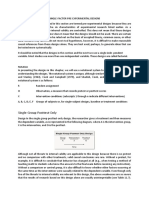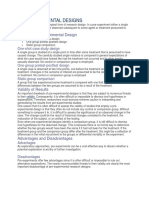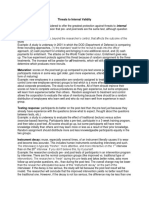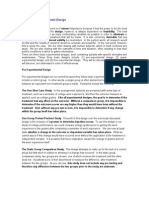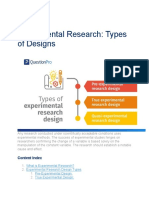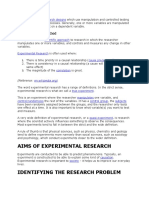Design
Design
Uploaded by
Jessa OrtegaCopyright:
Available Formats
Design
Design
Uploaded by
Jessa OrtegaCopyright
Available Formats
Share this document
Did you find this document useful?
Is this content inappropriate?
Copyright:
Available Formats
Design
Design
Uploaded by
Jessa OrtegaCopyright:
Available Formats
PRETEST-POSTTEST DESIGN
For many true experimental designs, pretest-posttest designs are the preferred method
to compare participant groups and measure the degree of change occurring as a result of
treatments or interventions.
Pretest-posttest designs grew from the simpler posttest only designs, and address some
of the issues arising with assignment bias and the allocation of participants to groups.
One example is education, where researchers want to monitor the effect of a new
teaching method upon groups of children. Other areas include evaluating the effects of
counseling, testing medical treatments, and measuring psychological constructs. The
only stipulation is that the subjects must be randomly assigned to groups, in a true
experimental design, to properly isolate and nullify any nuisance or confounding
variables.
Pretest-posttest designs are an expansion of the posttest only design with nonequivalent
groups, one of the simplest methods of testing the effectiveness of an intervention.
In this design, which uses two groups, one group is given the treatment and the results
are gathered at the end. The control group receives no treatment, over the same period
of time, but undergoes exactly the same tests.
Statistical analysis can then determine if the intervention had a significant effect. One
common example of this is in medicine; one group is given a medicine, whereas the
control group is given none, and this allows the researchers to determine if the drug
really works. This type of design, whilst commonly using two groups, can be slightly
more complex. For example, if different dosages of a medicine are tested, the design can
be based around multiple groups.
Whilst this posttest only design does find many uses, it is limited in scope and contains
many threats to validity. It is very poor at guarding against assignment bias, because the
researcher knows nothing about the individual differences within the control group and
how they may have affected the outcome. Even with randomization of the initial groups,
this failure to address assignment bias means that the statistical power is weak.
The results of such a study will always be limited in scope and, resources permitting;
most researchers use a more robust design, of which pretest-posttest designs are one.
The posttest only design with non-equivalent groups is usually reserved
for experiments performed after the fact, such as a medical researcher wishing to
observe the effect of a medicine that has already been administered.
PROBLEMS WITH PRETEST-POSTTEST DESIGNS
The main problem with this design is that it improves internal validity but
sacrifices external validity to do so. There is no way of judging whether the process of
pre-testing actually influenced the results because there is no baseline measurement
against groups that remained completely untreated. For example, children given an
educational pretest may be inspired to try a little harder in their lessons, and both
groups would outperform children not given a pretest, so it becomes difficult
to generalize the results to encompass all children.
The other major problem, which afflicts many sociological and educational research
programs, is that it is impossible and unethical to isolate all of the participants
completely. If two groups of children attend the same school, it is reasonable to assume
that they mix outside of lessons and share ideas, potentially contaminating the results.
On the other hand, if the children are drawn from different schools to prevent this, the
chance of selection bias arises, because randomization is not possible.
The two-group control group design is an exceptionally useful research method, as long
as its limitations are fully understood. For extensive and particularly important
research, many researchers use the Solomon four group method, a design that is more
costly, but avoids many weaknesses of the simple pretest-posttest designs.
The statistical treatment of data that will be used for this research design is the T-TEST.
You might also like
- Visual Miscellaneum - A Colorful Guide To The World's Most Consequential Trivia - The Bestselling Classic, Revised and UpdatedDocument258 pagesVisual Miscellaneum - A Colorful Guide To The World's Most Consequential Trivia - The Bestselling Classic, Revised and UpdatedAndra Teodora POPESCU100% (1)
- Between Subjects DesignDocument4 pagesBetween Subjects Designterezki100% (1)
- One Group Pretest PosttestDocument4 pagesOne Group Pretest Posttestirmitha mufidaNo ratings yet
- COM142 - C Programming Final ExamDocument10 pagesCOM142 - C Programming Final ExamPipin FitriadiNo ratings yet
- Pretest Post Test DesignDocument2 pagesPretest Post Test DesignKim NaNo ratings yet
- Pretest-Posttest Designs: The Posttest Only Design With Non-Equivalent Control GroupsDocument8 pagesPretest-Posttest Designs: The Posttest Only Design With Non-Equivalent Control Groupshybrid2112No ratings yet
- Day 2 Reporting PR 2Document5 pagesDay 2 Reporting PR 2Loujean Gudes MarNo ratings yet
- Assignment ON Advance Research Methods and Statistics in Education (M.ED./3/CC/302)Document7 pagesAssignment ON Advance Research Methods and Statistics in Education (M.ED./3/CC/302)KC.LalmumpuiiNo ratings yet
- One-Shot Case Study Design (One-Group Posttest Only)Document5 pagesOne-Shot Case Study Design (One-Group Posttest Only)vanshitamehta2303No ratings yet
- Threats To ValidityDocument5 pagesThreats To ValidityAbhijeet DandageNo ratings yet
- Chapter 5.experimental DesignDocument5 pagesChapter 5.experimental DesigndanieljohnarboledaNo ratings yet
- Pretest-Posttest Designs - Experimental ResearchDocument11 pagesPretest-Posttest Designs - Experimental ResearchNeseth Eleuterio BadatoNo ratings yet
- What Sampling Method Is Best For Small PopulationDocument3 pagesWhat Sampling Method Is Best For Small PopulationChreze If TorioNo ratings yet
- Experimental ResearchDocument8 pagesExperimental ResearchEDNA MAY SANCHEZNo ratings yet
- Pr2 HandoutDocument6 pagesPr2 HandoutShahanna GarciaNo ratings yet
- Name: Jani Patience Reg No Course Name Quntitative Research Methods Course Covener MuparamotoDocument5 pagesName: Jani Patience Reg No Course Name Quntitative Research Methods Course Covener MuparamotoLurvmre Mixtel ChirubvuNo ratings yet
- Experimental Research by Dr. Virendra Singh ChoudharyDocument4 pagesExperimental Research by Dr. Virendra Singh ChoudharyVirendra ChoudharyNo ratings yet
- Solomon Four-Group Design: February 2018Document5 pagesSolomon Four-Group Design: February 2018Vardhan SinghNo ratings yet
- LECTURE NOTES On Pretest and PosttestDocument4 pagesLECTURE NOTES On Pretest and Posttestmarvin jayNo ratings yet
- Quasi Experimental Method 3Document6 pagesQuasi Experimental Method 3Moumi RoyNo ratings yet
- Understanding Research Studies 2010Document4 pagesUnderstanding Research Studies 2010tiruchanurNo ratings yet
- 21.cpsy.34 Research MethodsDocument14 pages21.cpsy.34 Research MethodsVictor YanafNo ratings yet
- TRUE and QUACY EksperimentsDocument3 pagesTRUE and QUACY EksperimentsERNI FORWATYNo ratings yet
- Experimental ResearchDocument4 pagesExperimental ResearchJeza Estaura CuizonNo ratings yet
- Lecture Notes: Take Note! Characteristics of A Good Experimental DesignDocument5 pagesLecture Notes: Take Note! Characteristics of A Good Experimental Designmarvin jay0% (1)
- Chapter 1 Lesson 1 Characteristics StrenDocument4 pagesChapter 1 Lesson 1 Characteristics StrenDanielaNo ratings yet
- AP Statistics Review: Planning A Study: Key Terms and ConceptsDocument12 pagesAP Statistics Review: Planning A Study: Key Terms and ConceptsldlewisNo ratings yet
- Kinds of Quantitative ResearchDocument3 pagesKinds of Quantitative ResearchAugusto Dolores RholuNo ratings yet
- Experimental ResearchDocument5 pagesExperimental ResearchKurniawanHidayatNo ratings yet
- Aims of Experimental ResearchDocument4 pagesAims of Experimental Researchliljev_mooNo ratings yet
- Extraneous VariablesDocument3 pagesExtraneous VariablesAmna MazharNo ratings yet
- Charman 2019Document3 pagesCharman 2019Sergio Machado NeurocientistaNo ratings yet
- Characteristics of Quantitative ResearchDocument31 pagesCharacteristics of Quantitative ResearchDayhen Afable BianesNo ratings yet
- Validity of Experimental DesignDocument4 pagesValidity of Experimental DesignAhmad KtsNo ratings yet
- Experimental DesignDocument13 pagesExperimental DesignKyrahFaithAquilizan100% (2)
- Unit 2 Experimental Design PDFDocument15 pagesUnit 2 Experimental Design PDFvarshneypalak0No ratings yet
- Experimental ResearchDocument11 pagesExperimental ResearchShaz Maria100% (1)
- Characteristics Strengths Weaknesses Kinds ofDocument52 pagesCharacteristics Strengths Weaknesses Kinds ofKim Ann OpenaNo ratings yet
- Experiment ResearcDocument7 pagesExperiment ResearcNathNo ratings yet
- Aims of Experimental ResearchDocument11 pagesAims of Experimental Researchgratiamadelo0% (1)
- Quasi EksperimentalDocument3 pagesQuasi EksperimentalMitasariNo ratings yet
- Experimental & Quasi Experimental DesignDocument70 pagesExperimental & Quasi Experimental DesignSathish Rajamani100% (1)
- The Use of The Solomon Four-Group Design in NursinDocument8 pagesThe Use of The Solomon Four-Group Design in Nursinandre siahaanNo ratings yet
- Experimental and Quasi Experimental Method UG IIIDocument29 pagesExperimental and Quasi Experimental Method UG IIIcocodream742No ratings yet
- PR2 Mod 1Document60 pagesPR2 Mod 1Jan Loven Del RosarioNo ratings yet
- Types of Experimental ResearchDocument2 pagesTypes of Experimental Researchzanderhero30No ratings yet
- Kinds of Quantitative Research DesignsDocument23 pagesKinds of Quantitative Research Designsmargilyn ramosNo ratings yet
- Rawalpindi Women University: Research Methodology Ii Group MembersDocument11 pagesRawalpindi Women University: Research Methodology Ii Group MembersSyeda Sabahat BatoolNo ratings yet
- Phenomenology: Philosophy Husserl HeideggerDocument14 pagesPhenomenology: Philosophy Husserl Heideggerlinda kumala dewiNo ratings yet
- EXPEREMENTAL Experimental Research Is A StudyDocument7 pagesEXPEREMENTAL Experimental Research Is A Studybeljanske ocarizaNo ratings yet
- Essential Elements of The Research MethodologyDocument8 pagesEssential Elements of The Research MethodologyMaika Pilley DaduboNo ratings yet
- ASSIGNMENTRESEARCHDocument11 pagesASSIGNMENTRESEARCHrimsha alishbaNo ratings yet
- Quantitative Research DesignDocument18 pagesQuantitative Research DesignJude Renan Bido100% (2)
- Dose Response StudiesDocument2 pagesDose Response StudiesSooraj Rajasekharan KarthaNo ratings yet
- Kinds of Experimental ResearchDocument7 pagesKinds of Experimental Researchdewi nur yastutiNo ratings yet
- What Is Experimental Research?: InstructionDocument5 pagesWhat Is Experimental Research?: InstructionJasmine Cruz SalvaniNo ratings yet
- 05-Experimental Research Design 2017Document22 pages05-Experimental Research Design 2017Whatever UseeNo ratings yet
- Randomized Control Trial, Cohort & Case StudiDocument15 pagesRandomized Control Trial, Cohort & Case StudiDintaNo ratings yet
- Clinical Trials Design and Methodology: Clinical Trials Mastery Series, #3From EverandClinical Trials Design and Methodology: Clinical Trials Mastery Series, #3No ratings yet
- Help - Gaisma (Sunrise Sunset)Document3 pagesHelp - Gaisma (Sunrise Sunset)ronniedakingpouNo ratings yet
- Information Age: Instr. Jeremiah G. PedralDocument31 pagesInformation Age: Instr. Jeremiah G. PedralMac VillanuevaNo ratings yet
- India Kailasa 4.1.3Document17 pagesIndia Kailasa 4.1.3Aditya Kumar SinghNo ratings yet
- Caroline McGee - Childhood Experiences of Domestic Violence - The Herd, Primal HordeDocument255 pagesCaroline McGee - Childhood Experiences of Domestic Violence - The Herd, Primal HordeRinaldy And WifeNo ratings yet
- ProceedingsDocument111 pagesProceedingsSalma SherbazNo ratings yet
- EC Catalog2009Document24 pagesEC Catalog2009gad30No ratings yet
- 2010 - 03 - 2415 - 51 - 00BC-5800 Difference With BC-5500Document30 pages2010 - 03 - 2415 - 51 - 00BC-5800 Difference With BC-5500samuel debebeNo ratings yet
- Levelling HandbookDocument45 pagesLevelling HandbookLing Shyan Jong100% (1)
- Panirchelvan RamanathanDocument40 pagesPanirchelvan RamanathanDimas FauziNo ratings yet
- Banner-Animation AtlasDocument6 pagesBanner-Animation AtlasĐông NguyễnNo ratings yet
- 0910 Bow Tie Risk Paulo RheinboltDocument20 pages0910 Bow Tie Risk Paulo RheinboltJuan JoséNo ratings yet
- Grade 9 Number Systems T1Document3 pagesGrade 9 Number Systems T1Prash2411No ratings yet
- Language, Music and Computing - Mitrenina, Eds - 2019 PDFDocument239 pagesLanguage, Music and Computing - Mitrenina, Eds - 2019 PDFAngelRibeiro10No ratings yet
- NDT PT ProcedureDocument13 pagesNDT PT ProcedureSandiSandii100% (1)
- Ethics For Speech-Language Pathologists and Audiologists: An Illustrative CasebookDocument17 pagesEthics For Speech-Language Pathologists and Audiologists: An Illustrative CasebookJesus Mata CastroNo ratings yet
- Discovery Leaflet - Maths and Further Maths 2023Document2 pagesDiscovery Leaflet - Maths and Further Maths 2023Bhanu NadellaNo ratings yet
- Numerical Methods Lecture (Autosaved)Document126 pagesNumerical Methods Lecture (Autosaved)KenneyNo ratings yet
- Vehicle Registration Search: Services (AOS)Document1 pageVehicle Registration Search: Services (AOS)Durga Prasad KadirireddyNo ratings yet
- Summit Manual 10629 07-03-17 (700-20010)Document81 pagesSummit Manual 10629 07-03-17 (700-20010)Giuliana EscajadilloNo ratings yet
- BR - No.93-Mcc Pier AdequacyDocument42 pagesBR - No.93-Mcc Pier AdequacyMuthukumaranNo ratings yet
- Chemistry IPDocument9 pagesChemistry IPMOHAMED IBRAHIMNo ratings yet
- 12 7 2018 8 10 51 Am721@444Document11 pages12 7 2018 8 10 51 Am721@444xaytopsNo ratings yet
- Project - Proposal BSPDocument4 pagesProject - Proposal BSPMarvin GrumalNo ratings yet
- Advanced Artificial Lift Methods - PE 571: Prepared by Dr. NguyenDocument34 pagesAdvanced Artificial Lift Methods - PE 571: Prepared by Dr. NguyennaefmubarakNo ratings yet
- Deferred Rendering in Kill ZoneDocument55 pagesDeferred Rendering in Kill Zonesscherten3184100% (1)
- Multi User DetectionDocument75 pagesMulti User DetectionShabeeb Ali OruvangaraNo ratings yet
- Manual AquaSnapDocument100 pagesManual AquaSnapplastico852100% (1)
- Test2 SLHL Exp Log Functns v1Document1 pageTest2 SLHL Exp Log Functns v1jefferyNo ratings yet


